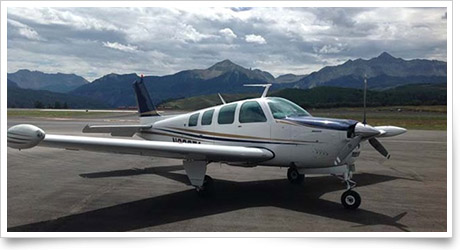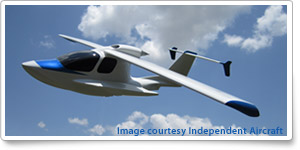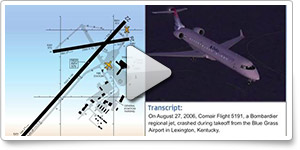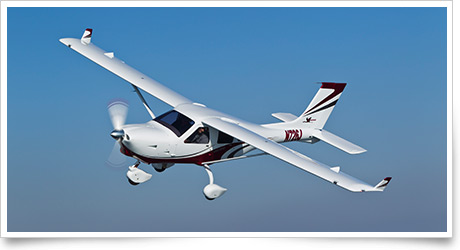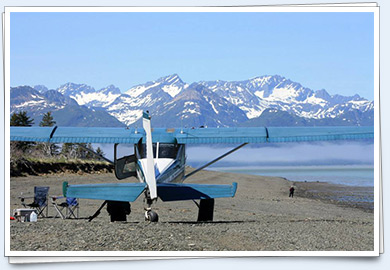| |||||
FeaturedCell phone call solves lost-com emergency
| |||||||||||||||||||||||||||||||||||||||||||||||||||
Flight Instructor Refresher Courses |
Air Safety Institute Safety Seminars | |||||||||
For a complete schedule, see AOPA Online. Can't make it in person? Sign up for the Air Safety Institute's new Online eFIRC. |
Topics vary—for details and a complete schedule, see AOPA Online. | |||||||||
Advocacy
House committee supports small aircraft revitalization bill
A bill setting an end-of-2015 deadline for the FAA to revamp small-airplane certification rules has won a House committee's support. Read more >> 


FAA releases final ATP certification rule
The FAA has issued the final rule that increases the qualification requirements for first officers. AOPA is concerned that the rule will have a negative effect on Part 61 flight training providers and new student pilot starts. Read more >> 


 AOPA Now: House GA Caucus sets new record
AOPA Now: House GA Caucus sets new record
The House General Aviation Caucus recently set a new record, with 197 members. "At a time when general aviation seems to be under constant attack from those who don't understand us or just don't care, I'm excited to tell you that there's a growing group of decision makers who are taking action to both understand and protect GA," writes AOPA President Craig Fuller. Read more >> 


New training standards would add safety, relevance
New standards proposed for private pilot and instrument-rating certification would improve training and place all skill and knowledge requirements in one "easily identifiable document" for each, AOPA said in a regulatory filing. Read more >> 


Aviation gains hard-fought tax victory in Pennsylvania
Years of determined advocacy for general aviation have been rewarded in Pennsylvania, where a bill to exempt the sale at retail or use of aircraft parts, services to aircraft, and aircraft components from a 6-percent sales tax has been signed into law. Read more >> 


FAA phasing out direct sales of paper charts
The FAA, in a cost-reduction effort, has discontinued direct-to-the-public subscription sales of paper aeronautical charts and related products. Nonsubscription sales to individuals will end Oct. 1. Current subscriptions will be filled until their expiration dates. Read more >> 


Member Benefits
Five good reasons to say yes to a business aircraft
Small businesses and entrepreneurs can use general aviation aircraft to gain a competitive advantage. AOPA Aviation Finance Co. tells members how. Read more >> 


Documents pilots need to provide for conditions AMEs can issue
Dr. Warren S. Silberman offers pointers on what you need to get your treating physician to provide to you prior to visiting your aviation medical examiner if you have glaucoma, chronic hepatitis C, hypothyroidism, or hypertension. Read more >> 


AOPA Strategic Partner spotlight: Aircraft Spruce & Specialty
 Aircraft Spruce is supporting AOPA members by offering periodic special offers and discounts on aircraft parts and pilots supplies, and through sponsorship of AOPA Aviation Summit and the Aircraft Maintenance column on AOPA.org. The company also provides financial support that helps AOPA promote, protect, and defend general aviation. Join Aircraft Spruce at EAA AirVenture at booths 1022 through 1029, 4113, 4114, and 476. Visit Aircraft Spruce's website to learn more.
Aircraft Spruce is supporting AOPA members by offering periodic special offers and discounts on aircraft parts and pilots supplies, and through sponsorship of AOPA Aviation Summit and the Aircraft Maintenance column on AOPA.org. The company also provides financial support that helps AOPA promote, protect, and defend general aviation. Join Aircraft Spruce at EAA AirVenture at booths 1022 through 1029, 4113, 4114, and 476. Visit Aircraft Spruce's website to learn more. 


Two new offers for members
AOPA members can receive $10 off a $50 purchase at BanyanPilotShop.net and free pilot training software from avtutorials.com through two new offers added to the Lifestyles Member Discount program. Log in to take advantage of these offers >> 


AOPA Career Opportunities
Ever dream of turning your passion for aviation into a career? We're looking for a marketing specialist, member services representative, human resources assistant, software test and quality assurance analyst, and AOPA Live editor/graphic artist. To learn more about other AOPA career opportunities, visit AOPA Online. 


training tipsThe why of winglets
|
Community
Picture PerfectAOPA's online photo gallery allows you to upload your own aviation photography as well as view, rate, and comment on others' photos. Your favorite aviation images from AOPA Pilot are still available online through this new gallery. Take a look, and submit your own photos!! |
| |
Engage in AviationCheck out user-submitted events from your region. To include an event or to search all events in the calendar, visit AOPA Online. AOPA does not endorse the events listed below, nor have ePilot editors edited the submissions. AOPA assumes no responsibility for events listed. Northeast aviation eventsJul 13 — Stow, Massachusetts. Minute Man Airfield (6B6). Young Eagles Rally. Jul 14 — East Windsor, Connecticut. Skylark Airpark (7B6). French Toast Breakfast. Jul 14 — Cortland, New York. Cortland County - Chase Field (N03). Cortland AirFest 2013.
For descriptions of the events in this region, see the online calendar of events. Eastern aviation eventsJul 13 — Cincinnati, Ohio. Clermont County/Sporty's (I69). Sporty's Saturday Hot Dog Fly-In. Jul 13 — Toughkenamon, Pennsylvania. New Garden (N57). EAA 240 Pancake Breakfast Fly-in and Young Eagles. Jul 20 — Port Clinton, Ohio. Erie-Ottawa Regional Airport (PCW). Ice Cream Fly-In Social. Jul 20 — Cincinnati, Ohio. Clermont County/Sporty's (I69). Sporty's Saturday Hot Dog Fly-In. Jul 21 — Indiana, Pennsylvania. Jimmy Stewart Airport (KIDI). Jimmy's Canteen.
For descriptions of the events in this region, see the online calendar of events. Midatlantic aviation eventsJul 13 — Westminster, Maryland. Carroll County (KDMW). First Mid-Atlantic Gathering of RVs. Jul 14 — Greensboro, North Carolina. Air Harbor Airport (W88). Piedmont Aero Club Summer Membership Drive and BBQ. Jul 21 — Woodruff, South Carolina. Triple Tree (SC00). South Carolina Breakfast Club.
For descriptions of the events in this region, see the online calendar of events. Florida aviation eventsJul 13 — Tallahassee, Florida. Tallahassee Regional Airport (KTLH). WINGS Seminar - Safe Navigation of Military Airspace. Jul 16 — Orlando, Florida. Orlando Sanford Airport (KSFB). IMC Club Meeting. Jul 20 — New Smyrna Beach, Florida. New Smyrna Beach Municipal (KEVB). Timeless Wings & Wheels Fly-in Breakfast.
For descriptions of the events in this region, see the online calendar of events. Southeast aviation eventsJul 13 — Bowling Green, Kentucky. Bowling Green/ Warren County Airport (KBWG). Family Aviation Day.
For descriptions of the events in this region, see the online calendar of events. Great Lakes aviation eventsJul 13 — Friendship, Wisconsin. Adams County Legion Field (63C). Young Eagles Rally. Jul 13 — Mason, Michigan. Mason Jewett Airport (KTEW). Young Eagles. Jul 13 — Richmond, Indiana. Richmond Municipal Airport (KRID). Second Saturday Pancake Breakfast. Jul 13 — Sheridan, Indiana. Sheridan Airport (5I4). Wheels & Wings Fly-In Cruise-In. Jul 13 — Fort Wayne, Indiana. Smith Field Airport (SMD). EAA Chapter 2 Pancake Breakfast. Jul 13 — Marshall, Michigan. Brooks Field Airport (KRMY). Airport Movie Night. Jul 14 — Ray, Michigan. Ray Community Airport (57D). Young Eagles at Ray Airport. Jul 14 — Middleton, Wisconsin. Middleton Municipal Airport/Morey Field (C29). EAA Chapter 1389 Fly-In Breakfast. Jul 16 — Madison, Wisconsin. Dane County Truax Field (KMSN). Meeting of IMC Club Madison WI Chapter. Jul 20 — Washington Island, Wisconsin. Washington Island Airport (2P2). 60th Annual Fly-In White Fish Boil. Jul 20 — Indianapolis, Indiana. Indianapolis International Airport (IND). Flight1 Community Day Celebration.
For descriptions of the events in this region, see the online calendar of events. Midwest aviation eventsJul 17 — Maryland Heights, Missouri. Missouri Pilots Assn Gateway Chapter. Jul 20 — Rushford, Minnesota. Rushford Municipal Airport (55Y). Rushford Days Fly/Drive-In. Jul 20 — South St. Paul, Minnesota. Fleming Field (KSGS). Seminar - "Stayin' Alive". Jul 20 — Ottawa, Kansas. Ottawa Municipal (KOWI). Airport Day.
For descriptions of the events in this region, see the online calendar of events. Southwest aviation eventsNo events have been submitted for the Southwest region through next weekend. Submit your own in the online calendar of events. Central aviation eventsJul 13 — Erie, Colorado. Erie (EIK). 5th Annual Spirit of Flight Day . Jul 13 - Jul 14 — Wayne, Nebraska. Wayne Municipal/Stan Morris Field (KLCG). Wayne Chicken Show Airport Fly-in.
For descriptions of the events in this region, see the online calendar of events. Western aviation eventsNo events have been submitted for the Western region through next weekend. Submit your own in the online calendar of events. California aviation eventsJul 20 — Hanford, California. Hanford Municipal Airport (KHJO). Display Day, Breakfast, & Young Eagles. Jul 21 — La Verne, California. Brackett Field (POC). Summer Fly In .
For descriptions of the events in this region, see the online calendar of events. Northwest aviation eventsJul 19 - Jul 20 — Prosser, Washington. Prosser (S40). Prosser Airport Days & Fly In. Jul 20 — Hillsboro, Oregon. Stark's Twin Oaks Airpark (7S3). 2013 Oregon Air Rally.
For descriptions of the events in this region, see the online calendar of events. Hawaii aviation eventsNo events have been submitted for Hawaii through next weekend. Submit your own in the online calendar of events. Alaska aviation eventsNo events have been submitted for Alaska through next weekend. Submit your own in the online calendar of events. | |
| |
QUIZ ME!Here's an edited question asked by an AOPA member who contacted our aviation services staff through the AOPA Pilot Information Center. Test your knowledge.
Question: My friend forgot to extend the landing gear before landing which resulted in a gear-up landing. There were no injuries but there is minor damage to the propeller and dents in the lower cowl and fuselage. Do I need to report this to the National Transportation Safety Board (NTSB)?
Answer: The NTSB requires aircraft operators to immediately report all aircraft accidents and certain serious incidents. The operator must determine if the gear-up landing falls into either category. According to the regulation, this is not a serious incident that requires immediate notification. It may be an accident, but that depends on the extent of the damage. The operator must determine if the damage in this event meets the NTSB definition of substantial damage. If unsure if the damage to the aircraft would qualify the event as an accident, it would be wise to seek legal counsel before speaking to the NTSB or FAA.
Got a question for our aviation services staff? The AOPA Pilot Information Center is a service available to all members as part of the annual dues. Call 800/USA-AOPA (800/872-2672), or email to [email protected]. |
|
| |
|
|
|
| ||||
|
ePilot Editor: |
Contributors: |
Alton K. Marsh |
Production Team: |
Advertise in ePilot: |
|
Member Tools: Send feedback | ePilot Archive © 2013 Aircraft Owners and Pilots Association | 421 Aviation Way Frederick, MD 21701 | Phone 800/USA-AOPA | Fax 301/695-2375 | ||||

